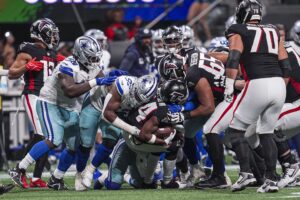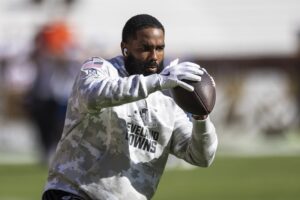Identifying regression candidates so you can properly rank them is an annual tradition in fantasy football. While some people use the terms “regress” and “bust” synonymously, that’s not true for the scope of this article. Honestly, it’s possible to confuse two because it all depends on how you define each term. If you interpret a bust as someone who simply doesn’t live up to their draft day cost, then yes, the following regression candidates are also bust candidates. However, “regression” here is defined as a movement back towards the mean (the same as it was here).
Finding a running back who will regress isn’t as simple as looking at one statistic. However, touchdowns are fluky. If a high touchdown total propped up a player’s value last season, you can reasonably expect that number to trend downward. For instance, Todd Gurley‘s six receiving touchdowns are going to be difficult to repeat. You should also focus on efficiency numbers. Focus on yards per carry, yards per touch, yards per receptions, and breakaway runs. Then compare those numbers to their career averages to see if their current production was an outlier.
Here are the running back regression candidates found using this process.
(All average draft position–ADP–information is from Fantasy Football Calculator. All statistical information is from Player Profiler and Pro Football Reference.)
Fantasy Football Running Backs: Regression Candidates for 2018
Alvin Kamara
ADP: 5.8 (standard), 6.1 (PPR)
Positional ADP: RB5
How do you possibly follow up that act? Last season Alvin Kamara arguably had the most efficient running back season of all-time. He led the league in yards per carry (6.1), breakaway run rate (9.2 percent), receiving yards from a running back (826), and he was second in running back receptions (82) and yards per touch (7.7). Remarkable. Remarkable and hard to repeat.
History showed us that it was foolish for us to expect Die Hard 2 to be as good as the first. And it is certainly foolish to expect Kamara to be as efficient this season. Simply put, he will not repeat his 6.1 yards per carry. Even if he was Jamaal Charles good, Kamara would still lose nearly 120 rushing yards from his 2017 numbers. Now, regression will hit Kamara, but he can still prove to be worth the price tag. He is still on an offense led by Drew Brees, so all Kamara needs is for that not to change and to increase his carries this year to offset the loss in efficiency. If that can happen (Mark Ingram‘s suspension doesn’t exactly guarantee it), then his chances at maintaining his draft day value become more likely.
Kareem Hunt
ADP: 9.4
Positional ADP: RB8, RB7
Kareem Hunt finished last season as the fourth best running back (1/2 PPR), and yet he is typically the seventh or eighth running back off the board in current drafts. While Hunt’s regression doesn’t figure to be significant, there are some concerns going forward. Namely, will he be able to repeat his opportunity share from last year (third best in the league)? Spencer Ware‘s vague status concerning his health could be a reason that Hunt will repeat; however, the Kansas City Chiefs did sign Kerwynn Williams and Damien Williams to add to the running back room that also includes Charcandrick West.
Another concern is the fact that Hunt led the league in runs of 15 yards or more (18). Simply put, that’s going to be hard to duplicate. Although, one reason to bet on Hunt is that he led the league in evaded tackles (137), which is one of the stickier stats in the game. So it’s not all doom and gloom for Hunt.
Alex Collins
ADP: 34.5 (standard), 36.8 (PPR)
Positional ADP: RB19
Alex Collins was a great story last year, but like Hunt, he has some concerns going forward. First, he was second in the league in runs of 15 yards or more (16). As said before, stats like that are hard to repeat. Second, Collins didn’t impress as a receiver. His catch rate (63.9 percent) and drop rate (8.3 percent) leave a lot to be desired. The Baltimore Ravens also have pass catching options on their depth chart, which means that Collins will have a harder time receiving a significant opportunity share. Collins will need positive and neutral game scripts for him to match his success from last season.
Dion Lewis
ADP: 68 (standard), 56.1 (PPR)
Positional ADP: RB31, RB26
Volume is key in fantasy football. The question here is if Dion Lewis will receive enough volume to maintain his same numbers from last year. Last season, Lewis had 180 carries, which ranked 22nd in the league and finished 14th in fantasy points (1/2 PPR). Obviously, Lewis was really efficient with his touches last year. The fact that he was ninth in the NFL in runs of 15 yards or more (10) helps to demonstrate that point. So, either Lewis will need to continue to be as efficient, which is less likely, or he will have to grab more carries away from Derrick Henry. If the volume isn’t there, he’ll be hard-pressed to match his point total from last year.
Chris Thompson
ADP: 100.8 (standard), 75.2 (PPR)
Positional ADP: RB42, RB33
Did Chris Thompson progress to a new, sustainable level last year? Or was last season more of an aberration? Thompson has been in the league five years now, and his yards per reception are as follows: 0 (he didn’t play a game in his first season), 4.5, 6.9, 7.1, and 13.1. One of those numbers is definitely not like the others. If you were to spot Thompson a 7.1 yards per reception average, which is a number more in line with his career averages, he would have lost roughly 233 yards last season. That would have brought his points per game average (in 1/2 PPR) from 13.2 to 10.9, and that’s assuming the touchdown numbers stay the same. Regression is coming for Chris Thompson.
Honorable Mention
Jamaal Williams
Jamaal Williams‘ college production doesn’t indicate that he’s a talented receiver. His college target share fell into the 44th percentile, and the most receptions he had in a year was 27. Williams, who only had seven starts, amassed 25 receptions with a 10.5 yards per reception. That efficiency should take a hit.






